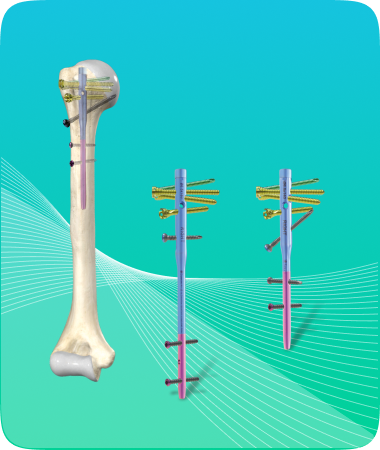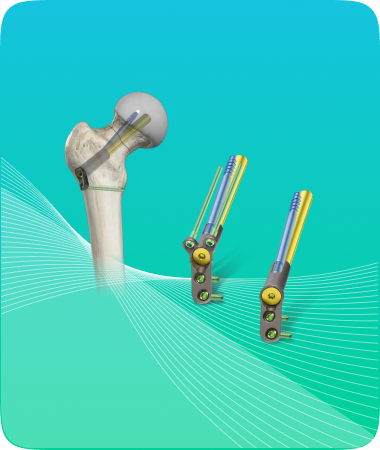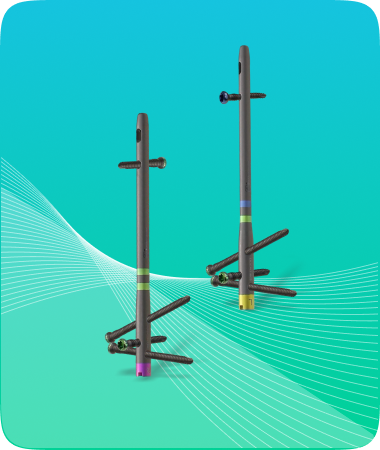Distal Tibia
The Sorath Distal Tibia and Fibula Plates are specialised orthopaedic implants designed for the fixation of fractures in the distal tibia and fibula. These plates are engineered to provide optimal stability, minimise soft tissue irritation, and accommodate various fracture types, particularly in complex surgical scenarios.


Twin Lock BCP Distal Tibia Plate
Complex intra-articular and extra-articular fractures and osteotomies of the distal tibia
Features
The plate is provided with a knob which sits anteriorly
Anatomically contoured; plate is twisted 20° and bent to fit the distal tibia
View More
- Four to fourteen holes in the shaft
Distal Kirschner wire hole for plate placement (⌀ 2.0 mm maximum)
Available in stainless steel or titanium
Oblong holes in the head & six round locking holes in the head (periarticular area
– distally) accept the following screws:Cannulated 3.7 mm locking and cannulated 3.7 mm conical screw (For compression)
3.5 mm cortex screws
3.5 mm locking screws
4.0 mm cancellous bone screws
The shaft holes accept 3.5 mm locking screws in the threaded portion and 3.5 mm cortex screws & 4.0 mm cancellous screw

Twin Lock BCP Medial Distal Tibia Plate
- Fixation of complex intra- and extra-articular fractures of the distal tibia (Tibial Plafond or Pilon fractures)
- Osteotomies of the distal tibia
Features
Twin Lock-BCP Medial Distal Tibial Plate (Left & Right) merges locking screw technology with conventional plating techniques
View More
- The Combi hole in the locking plate shaft combines a dynamic compression unit with a locking screw hole. Combi holes
provide the flexibility of axial compression and locking capability throughout the length of the plate shaft Locking screws provide the ability to create a fixed-angle construct which provides stable construct even in osteopenic bone or multifragment fractures where screw purchase is less. These screws do not rely on plate-to-bone compression to resist patient load, but function similarly to angled blade plates
Low profile head for minimal prominence on medial malleolus
3.5 mm cortex and 4.0 mm cancellous bone screws sit flush with plate in the nonlocking portion of distal combi-holes to
minimize screw prominence3.7 mm cannulated locking & 3.7 mm
cannulated conical (for compression) can be used distally in metaphyseal area
near jointRounded edges to minimize soft tissue irritation
Limited-contact shaft profile
Three distal locking screws diverge across
subchondral bone and are parallel to jointFour to fourteen Combi -holes in the shaft
Two distal combi-holes
Distal Kirschner wire hole for plate placement (⌀2.0 mm maximum)
Available in stainless steel or titanium
Oblong holes in the head & six round locking holes in the head (periarticular area – distally) accept the following screws:
oCannulated 3.7 mm locking and cannulated 3.7 mm conical screw (For compression)
o3.5 mm cortex screws
o3.5 mm locking screws
o4.0 mm cancellous bone screws

Twin Lock BCP Anterolateral Distal Tibia Plate
- Extra-articular and simple intra-articular distal tibia fractures
- Tibial Plafond (Pilon) fractures with involvement of lateral portion of articular surface
- Distal tibia fracture, percutaneous or reducible by limited arthrotomy
- Distal tibia fracture extending into the diaphyseal area
Features
Merges Conventional & Locking screw technology together
View More
- There is a 60 degree twist in the plate shaft as per the tibia anatomy making it more adaptable: less contouring
Round locking holes in the head accepts cannulated 3.7mm locking and 3.7mm cortical screw(for compression)/ 3.5mm L/C screws/4.0mm cancellous screws
The combi holes in the shaft accepts locking and cortical screws
The distal locking screws provide support to the articular surface

Stelios Fix Plate
Product Indications
The Twin Lock BCP Stelios Fix Plate is designed for the fixation of fractures and osteotomies of the distal femur and proximal tibia
Features
- These plates are pre-contoured to fit the medial proximal tibia, with a tapered end to facilitate minimally invasive insertion
- The proximal screws are angled for purchase in the tibial plateau, and the solid midsection provides the strength necessary to sustain the osteotomy
- The long shaft of the plate is designed to support and deflect forces in the diaphysis while locking screws create a fixed-angle construct to provide angular stability






